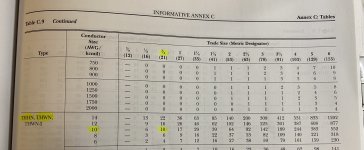You are using an out of date browser. It may not display this or other websites correctly.
You should upgrade or use an alternative browser.
You should upgrade or use an alternative browser.
RMC trade
- Thread starter Samuel87
- Start date
- Status
- Not open for further replies.
- Location
- Illinois
- Occupation
- retired electrician
The use of trade size 3/8 while provided for in the listing standards is not permitted to be used in an NEC application. In addition, only five of those conductors fit in a 1/2", so no way eight fit in 3/8".
3/4" is the correct size. No need for any calculations where the conductors are of the same size. You can use the tables in Annex C. The table for RMC is Table 9.344.20 Size.
(A) Minimum.
RMC smaller than metric designator 16 (trade size 1⁄2) shall not be used.
Tulsa Electrician
Senior Member
- Location
- Tulsa
- Occupation
- Electrician
It looks like that is table c-9.
Try C-8 for RMC.
Here is a tip.
All al blank continued headers insert table reference (RMC).
For PVC use ( sch40) or ( sch 80) and so on so you don't use incorrect table.
I trick up the the help with this at times then they learn to mark.
Try C-8 for RMC.
Here is a tip.
All al blank continued headers insert table reference (RMC).
For PVC use ( sch40) or ( sch 80) and so on so you don't use incorrect table.
I trick up the the help with this at times then they learn to mark.
- Location
- Illinois
- Occupation
- retired electrician
It looks like that is table c-9.
Try C-8 for RMC.
Here is a tip.
All al blank continued headers insert table reference (RMC).
For PVC use ( sch40) or ( sch 80) and so on so you don't use incorrect table.
I trick up the the help with this at times then they learn to mark.
| C.8 — Liquidtight Flexible Metal Conduit (LFMC) | 803 |
| C.8(A)* — Liquidtight Flexible Metal Conduit (LFMC) | 806 |
| C.9 — Rigid Metal Conduit (RMC) | 807 |
| C.9(A)* — Rigid Metal Conduit (RMC) | 810 |
| C.10 — Rigid PVC Conduit, Schedule 80 | 811 |
| C.10(A)* — Rigid PVC Conduit, Schedule 80 | 814 |
| C.11 — Rigid PVC Conduit, Schedule 40 and HDPE Conduit | 815 |
| C.11(A)* — Rigid PVC Conduit, Schedule 40 and HDPE Conduit |
Tulsa Electrician
Senior Member
- Location
- Tulsa
- Occupation
- Electrician
Thank you.
Changed in 2017.
I looked at my 2014 when I typed.
I was just going to correct when I seen you already did.
Sorry about that.
May be time to take that book and put on shelf with others.
Changed in 2017.
I looked at my 2014 when I typed.
I was just going to correct when I seen you already did.
Sorry about that.
May be time to take that book and put on shelf with others.
Carultch
Senior Member
- Location
- Massachusetts
An unfair problem they could give, would be to give you a 2-conductor situation, with a 24" or less length, expecting you to take credit for the nipple rule.I would have said 3/4" also but, since they did not give you a length and asked for minimum you could say 24" or less in which case it woudl be `1/2"
You can't physically fill a raceway to 60% using 2 identical conductors, as the maximum possible circle packing ratio is 50% by area for 2 circles in a circle. Yet, this is an oversight that could make it the "correct answer" on an academic exam.
3 identical circles pack at a 64.7% fill, so a 60% fill limit in a nipple is reasonable for 3 wires or more, or the trivial case of a single wire. Following the same logic that we use for allowing for 3 wires to fill a short nipple at 60% by area, the limit for 2 conductors should be 46% by area.
This is NEC 2020, has that one changed ?The table said View attachment 2564136
I got you, thanks.The use of trade size 3/8 while provided for in the listing standards is not permitted to be used in an NEC application. In addition, only five of those conductors fit in a 1/2", so no way eight fit in 3/8".
3/4" is the correct size. No need for any calculations where the conductors are of the same size. You can use the tables in Annex C. The table for RMC is Table 9.
- Status
- Not open for further replies.





